
|   |

|   |
Samavesh II - Supriya Rajan e-mail: supriya.dancer@gmail.com February 13, 2013 Lasyatarangini, the online forum for Mohiniattam artists, lovers and connoisseurs got together for the second time to celebrate the art form through its annual event Samavesh, in association with Alliance Francaise, Chennai, from January 7 to 13. The theme of this year’s event was THE JOURNEY OF MOHINIATTAM, which involved curating a pictorial essay of the art form along with talks and lec-dems by eminent Mohiniattam scholars and artistes. The opening day of Samavesh II had well known cultural activist Dr. VR Devika and Kalamandalam Kusum Gopalakrishnan as special guests. Speaking at the start of the event, VR Devika pointed out how the physical space is getting narrower and the cyber space is getting wider and wider. She hailed the online initiative of Lasyatarangini and said we must look at having such gatherings though virtual interfaces rather than physical interface in today’s scenario. Kusum Gopalakrishnan spoke about her initiation into dance training at the premier institute, Kerala Kalamandalam in the year 1960 and her journey with dance over the years. She appreciated Lasyatarangini for organizing Samavesh II, purely meant for the propagation of the dance form wherein disciples of many gurus from different parts of the world work together for a common cause keeping aside all differences that there may be. She expressed her belief that such sincere effort will surely bear fruit in the long run and urged the organizers not to be disappointed with the non-participation of many schools. Ms Phoebe, the cultural coordinator of the Alliance Francaise of Madras also spoke on the occasion. 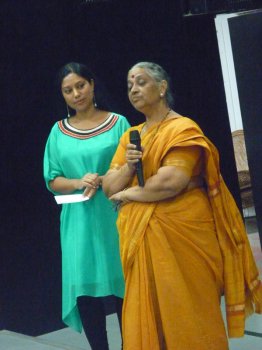 Shereen Saifudeen and Kusum Gopalakrishnan 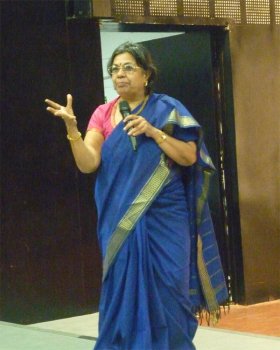 VR Devika Theatre artiste and contemporary dancer, Eugenia Carrillo also trained in trapeze and acrobatics. In 2000 she chanced upon a Kathakali performance and got completely enamoured by it and after four months she packed her bags to Kerala for learning the art form. After few months of her training in Kathakali she joined Kerala Kalamandalam and started her training in Mohiniattam under Guru Leelamma and her tryst with the dance form continues. Speaking at Samavesh 2, she revealed her perspective of Mohiniattam and about taking the dance form to Spain. Eugenia said her aim is not only to be a Mohiniattam artiste but to spread this beautiful dance form round the world. “Spain and India share many cultural similarities and both celebrate nature in their cultural and artistic expressions. When I first saw Mohiniattam I felt that I found something that I was looking for,” she said. “In theatre, we rely mainly on voice for expression but in Kathakali and Mohiniattam I could feel that it is poetry in motion. These two art forms I thought was a compilation of all that I learnt in dance, theatre and acrobatics where the body acts as an instrument of a musician. For a Mohiniattam dancer, the dance is like an instrument which is always with her to create music whenever she wants,” she added. She expressed gratitude to all the gurus who shared their knowledge with her – Kalamandalam Leelamma, Kshemavathy, Dr. Neena Prasad and Bharati Sivaji. They have given her the opportunity to taste the nectar of this eternal flower, she said. Mohiniattam for her is more than a style of dance; it is the essence of a particular feminine grace born in the soul of a woman. It is a celebration of nature through human body, a gift to Mother Nature, a subtle beauty which comes from inside. It cleverly uses the circular motion and fluidity and takes its character from the soul. According to her, the main strength of Mohiniattam is the abhinaya. The slow tempo enfolds nature in all its serenity and creativity. She has been completely dedicated to Mohiniattam since 2006 and started teaching the dance form in Spain from 2007. She gives intensive workshops to dancers across Spain and takes regular class in Madrid. To sustain the interest of students in the beginning stage, she said she makes them practice the adavus in a sequence to classical music which they are familiar with. In Flamenco, there is a word “dvende” which she said is similar to the word ‘rasa’ in India, which means magic created in a dancer when a number of factors come into play. Both dance forms she opined are connected with the passion involved in it and the power of feminine force. In today’s world when everyone prefers to put forth a very forcible or aggressive face to get ahead, Eugenia appealed to women to retain the feminine nature as it is a very powerful one. In western society, people are trying to regain this feminine factor which they lost in the struggle to be ahead. This makes Mohiniattam very appropriate in the present age, guiding women to find their true nature which is rooted in feminine grace that emanates great beauty, strength and power. She expressed her desire for the unification of Mohiniattam dancers with the main goal of bringing global audience to Mohiniattam. By nurturing a healthy mind and body, Mohiniattam is a source for aesthetic enjoyment. As her theatre master used to say that ‘the world need artistes,’ she said she believes ‘the world needs Mohiniattam dancers and teachers’ because she feels Mohiniattam is not only a dance form but a discipline that develops the personality. She presented a piece she choreographed in Mohiniattam to “Andaluza,” a composition of Enrique Granados, the famous Spanish composer of the 19th century. 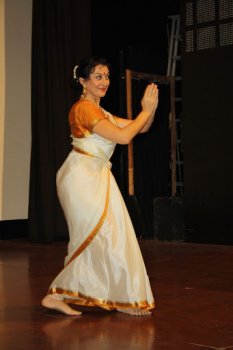 Eugenia Carrillo 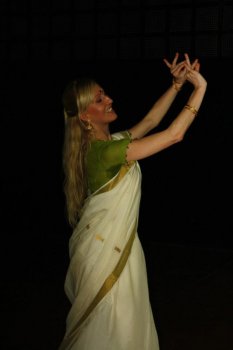 Anne Dietrich Anne Dietrich, a culture and dance educationist from Germany is trained in Ballet, Jazz, Contemporary dance, Improvisation Techniques and Theatre. She began her journey in Mohiniattam in 2005 when she started training under Guru Leelamma in Kalamandalam. She spoke about how she embraced Mohiniattam and her experiences and thoughts on the dance form and made a comparison between Mohiniattam and contemporary dance. “In classical ballet we speak only through body without any expression on the face and somehow I felt a deep desire to emote and tried to connect music, theatre and dance.” In 2004 she made her first production connecting the three and she found it really interesting to tell a story with good emotion to the audience. Her quest had just begun. She knew India existed and didn’t know much about the country until 2003 when her friend who was learning Kathakali passionately told her about Kerala Kalamandalam. While looking for more information she came to know about Mohiniattam and was instantly taken by its grace and femininity. Compared to the straight and jumpy movements in ballet, Mohiniattam looked more beautiful and using the facial muscles to emote was a fascinating aspect for her. She was also amazed as to how hand gestures are used to narrate stories. After watching Mohiniattam, Anne said she thought it would balance her personality as she is by nature very fast and Mohiniattam would help her slow down. She said she believes that dance can develop one’s personality. What was most amazing for her was the spiritual aspect of the dance where we can bring something from the heaven to the earth. She found it unbelievable that through dance you can communicate with god and as a spiritually awakened person she said she was totally enamoured by the dance form and she knew she had to come to Kerala and learn it. During her final year in college, she did many jobs and started saving money and as soon as she finished her degree, she took a flight to Kerala and went straight to Kerala Kalamandalam without knowing what to expect. All she knew when she started her journey was that she liked to learn Mohiniattam. At first, she thought she would use the rounded movements in Mohiniattam in her contemporary work but that idea soon changed and there was more in store for her. Her classes started the very next day she reached Kalamandalam. Prof Kalamandalam Leelamma was her teacher. Fondly remembering her guru, she said she feels very blessed to have Leelamma as her teacher because it is her effort and her love that has made her continue her tryst with Mohiniattam. She gave so much energy to her, said Anne. Speaking on the difficulties she had to face during the early learning period, first and foremost it was the culture shock which she had to overcome. Coming from a very sparsely populated region in Germany she had to come to terms with the crowd in India. The climate is different, the food is different and there is lot of action; everybody tries to speak to you. It took nearly three to four weeks for her to get accustomed to this. At some point she said she asked herself as to what she was doing amidst all these. But she was sure she somehow wanted to learn Mohiniattam. Suffer, but never give up so fast was her motto. As she wasn’t aware of the traditional practices, she didn’t know of the do’s and don’ts in Indian custom. Like touching gurus feet for blessing, squatting on the floor and not sitting on a chair in front of the guru and similar practices caught her by surprise and she was tense and careful not to make any mistake. She hadn’t heard about saree before. On the first day of class she was given a six meter cloth and she was taken aback when she was told that she had to wear that for dancing. “So many things go in our head coming into a new culture and society and it takes long time to settle in as each day is a challenge.” It is really tough but she said she liked the respect a teacher is given in India unlike in the West. “I was very confident that being a contemporary dancer able to do all the stretches, it will be easy to learn Mohiniattam,” but her opinion soon changed. The first exercise of sitting in aramandi and bending sideways made her realize that it isn’t going to be any easy task. In ballet and contemporary dance, the spine is kept erect and there is no sideways bending movement. She had to work hard to get these movements in her and she needed more than a year to do so. Same was the case with aramandalam and mudras. People in India are accustomed to use their hands while talking while in Germany the communication is strictly verbal without any animated movements. Anne said that it was difficult for her to train her hands to hold mudras. She had to do exercises to make her fingers move. After crossing this hurdle it was the facial expression which she had to get used to. Using the eyebrows, smiling, and the many things you can do with your face was very new to her. She worked hard to bring out these facial movements. She had to work even harder on eye movement. It was really amazing to know of the intricacies in the dance form and the effort one needs to put in to achieve them. Initially she had planned to stay for three months. But after realizing the enormity of learning lying ahead of her she decided to stay for one full year. This was a possibility because she had saved enough during her college days. After one year of learning Mohiniattam in Kerala Kalamandalam, Anne returned to her native place in Germany. It was almost like entering a new cultural zone for her. She recollected how she visited a supermarket in her village and she couldn’t find anyone there and nobody coming to talk to her. It was a great contrast to the setting she was living in for the past one year where you could see people everywhere trying to chat with you. She realized then that she missed the energy, the people, the femininity and grace of Mohiniattam. She kept coming to Kerala, to Guru Leelamma to further her learning. In 2004 she wrote a hundred page dissertation on teaching dance; the methodology, what teachers need to know about the anatomy of a dancer etc and she started her own research studies and met many gurus in Mohiniattam including gurus like Satyabhama, Nirmala Panicker and Pallavi Krishnan to understand the different approaches to teaching. She had a good exchange with Pallavi Krishnan and started to learn under her for a while. She realized there is so much more to learn and there are many more approaches to teaching. She rates her interaction with Pallavi Krishnan as very fulfilling because she could have open discussions. Since Pallavi Krishnan learnt from Bharati Sivaji, Anne got exposure to her style of teaching and through her she went to Bharati Sivaji and has been learning under her for the past one year. She found Bharati Sivaji’s methodology interesting since it has similarity to contemporary dance where the adavus are structured from simple to complicated and elementary to complex. It was interesting for her as it was more suitable for her to take this methodology to Germany. Anne was also impressed by Bharati Sivaji’s interest in taking care of the body with many body exercises. Anne said she gained a great deal from her and continues to be her disciple. “Before learning Mohiniattam I didn’t know there were many contents in dance. Understanding different methodologies is also important for a dancer as it helps in applying different approaches to the learning and teaching process. It is very difficult to describe contemporary dance because the development of Contemporary dance started in the modern era about 20 years ago when there were lot of changes in society and it was based on individual effort,” Anne said. The main idea of contemporary dance was to break away from the clear cut straight dancing of Ballet, where the body isn’t really inside of the dance and to become more individualistic dance style. It is a huge work which uses meditation and yoga techniques and a lot of teaching methodology and kinetic awareness as well as body therapies like Alexander technique. Each dancer uses these in various proportions resulting in a very individualistic style. In contemporary dance the movements are created from inside to outside instead of imitation from outside to inside. A dancer does a lot of research to understand the movement from inside. Since contemporary dance is completely separate from drama, Anne preferred to speak about the body movements in both the dance forms. Because contemporary dance is very young compared to Mohiniattam or other traditional dance forms, the contemporary dancers are also young. The purpose of secluding drama from contemporary dance is because the soul is separated from the body. And while contemporary dance is individualistic work of people, Mohiniattam is a more collective form which took shape in relation to the society, culture, music and drama. While Mohiniattam tells stories through facial expression and hand gestures as a communication with god, in contemporary dance, mostly the inner conflicts of man related to the world is portrayed. It is a pure dance where the body conveys emotions to the audience. Speaking of the technicalities of using time and space, Anne mentioned that Mohiniattam isn’t very space conscious dance form but a very time oriented one. The movements, the gestures and facial expression takes place in time, perfectly synchronized with the music and rhythm. This is the beauty of traditional Indian dance that it doesn’t use the space but the time. Mohiniattam doesn’t have big jumps and leaps and since western dance is created to use space and the floor, here floor means not just the space to place the feet but it is a new dimension, a partner. “In contemporary dance we use lot of jumps and leaps and we use lot of space. Before we start the class, we walk around to understand the space in order to know how we can use the space in relation to the floor,” she said. As for the approach of technique, in contemporary dance they use the whole body to create a story or motion. Each movement is traced to its source or the power center and the dancers try to understand which muscle is involved in the particular movement. Also, the individual anatomy of each dancer is studied and modifications are made in the movements to suit the dancer’s anatomy. The effort is to shape a good dancer out of what god has given. This is an important factor which every dance form can follow to observe and go deep into the anatomy. Though they rehearse each movement over and over, to imagine the movement and internalizing it gives more understanding and there will be a better coordination of the movements with the nerve centre, she said. In contemporary dance, she pointed out that gravity is used in the movements. Imagination of movements is also very important in contemporary dance. For example for a particular neck movement which she showed, she said she imagines how it will look if the neck is pulled using a string and accordingly create the desired movement. She uses this aspect in Mohiniattam by imagining particular movements in real life situations like being in water and moving the hands, being in honey and suddenly coming out of it etc. “For aramandalam I tell my students to imagine a pot full of water and the side bends as though the water is coming out of each side. It becomes easier to understand the movement when applied with imagination. When you realize from where the movement starts, the better.” Contemporary dance classes are usually of ninety minutes duration without any breaks or talks. If we break the session in between it isn’t good because the dancers need to achieve lot of flexibility. Like in Mohiniattam the classes begin with body exercises which are related to yoga. Some of the contemporary dancers begin the classes with the floor; i.e. by lying on the floor. At times she uses this approach to teach Mohiniattam too. She feels that when introducing the sideways (paarswa) bending movements to a newcomer while they are lying down with straight back, they get the right feel of it without having to concentrate on shifting or bearing the weight. After this, in Mohiniattam we move on to the adavus which are taught one after the other. In contemporary and ballet, she said that the different movements are taught in combination which they change periodically so that the dancer gets prepared for performance alongside learning. Unlike in Mohinattam there is no real learning of items. All that the choreographer needs to do is incorporate the appropriate combinations that the dancer already knows in a piece and so in a day or two the dancers can be readied for a performance. Another interesting factor that she said she finds in contemporary dance lessons is the time they use for improvisation after class. Since the dance form involves lot of inner flow, dancers listen to the music and try to understand what their body is trying to express. To get this connection with music, she said she plays music sometimes in Mohiniattam adavu class so that the students can feel the movement better. Anne’s main focus is to present Mohiniattam in Germany, through performance and lecture demonstrations. She performs in theatres, cultural events, for associations and also in events where they showcase Indian arts. She was of the opinion that when you present Mohiniattam as it is, people don’t enjoy much. It has to be presented in a very devotional atmosphere for audience to completely involve themselves in the performance. She mentioned about one of her performances which she had inside a church in Germany. There were about 100 to 150 people which she said is a lot in her country and she said after her one hour performance, they stood up and didn’t want to go home. The normally hurrying audience stayed back and went to her and said that they didn’t know what it is but it touched them, that it gave them great energy and was very special. This was proof that for Mohiniattam to create the real effect, the atmosphere needs to be set with the right devotional feel, she said. Normally she begins the concert with a cholkettu so that the audience gets a taste of the dance form and later she takes time to narrate the story and introduce some of the mudras for better comprehension. When they understand what the dancer is presenting, the audience feels very elated. She tries to give a lecture demo prior to the performance whenever possible. When people understand the depth, the intensity and the devotion involved in Indian classical dance, they come for the performance. Her endeavor thus has been to popularize the dance form in her country and she hoped that it becomes more and more famous across the globe. As in other parts of the world, she said Bharatanatyam and other dance forms are more famous in Germany. So she tries to introduce the dance form through performances and lec-dems and by speaking about her work. During her travels (in and outside the country), she said she speaks a lot about Mohiniattam. She has about fifteen students in her class for whom she gives special energy to make them come closer to Mohiniattam and once they learn and like the dance form, they are willing to make the dance their lifelong partner. Speaking about her teaching methodology, she said she had to adopt more introductory exercises. The bodies of western dancers are generally very stiff specially the spine and so she uses a lot of free falling exercises to loosen up the body. She adds a lot of imagination and introduces the basic movements of Mohiniattam which makes it easier for them to understand the movement. For side bending, she normally asks them to imagine being pulled by a string on both sides. She also observes the body shape of the student and tries to accommodate them suitably for Mohiniattam. Another factor which she lays stress on is the facial expression. Normally the people in Germany are less expressive through their body, specially the face. So she makes them sit in a circle after class and make them connect either with god or to the person in front and make them communicate through face. Also, she does exercises for eyes and neck sitting in the circle itself so that they can see each other and correct as well. Additionally they need to do exercises for fingers, wrists and hands since compared to Indian girls whose wrists are more flexible due to wearing bangles etc, the hands of westerners are more stiff. In her introductory sessions, she talks about different aspects of Indian culture, including a simple culinary session, so that they get more exposure to Indian culture. She concluded her talk with some pictures of her class and a video of introductory class session of Indian classical dance. Thanking all her gurus and the organizers of Samavesh II, Anne expressed her desire to see more unity among fellow artistes and gurus in Mohiniattam to take this divine art form forward. 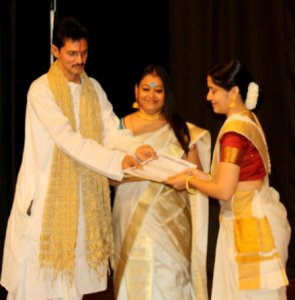 Nanditha Prabhu receiving the award from Venkat Vempati 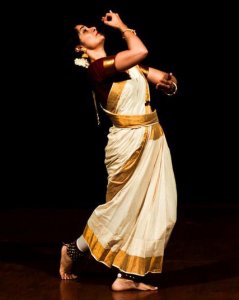 Nanditha Prabhu (Pic: Sam Kumar) Representing her guru and mother Kalamandalam Sugandhi and her research guide and guru in Natyashastra, Dr. Padma Subrahmanyam and all the artistes and scholars who have helped her in her research studies, Nanditha Prabhu shared her understanding of the traditional music of Kerala which she internalized as part of her research studies on the ritual dance forms of Kerala and the traditional music of the region. There is a very cardinal relationship between music and dance; music is the mystery that dance tries to reveal and the two coexist in all performing arts tradition, she said. For a thorough understanding, she began with an introduction from Natyashastra the earliest Pan-Asian text on dance drama. Though the term Performing Arts came into use in 18th century, Bharata Muni says that Natya (Performing Arts) ends in rasanishpathi; emergence of a rasa and a summary of elements that leads to it is also mentioned. In Natya Sangraha, he says rasa emerges from a psychological state of mind called the bhava. The bhava which the performer feels is the bhavakatva and when it reaches the audience it is bhojakatva, finally it ends in siddhi, either Manushika Siddhi or Daivika Siddhi. Of the eleven elements that work in tandem Nanditha threw light on Svaras, Aatotyam and Gaanam to talk about the traditional music of Kerala. She pointed out how in the olden times, there was great cultural exchange that happened between the many regions of Bharatavarsha. Though not territorially divided like today, the Bharatavarsha was mentioned to comprise of four Pravirthis: Panchali (North), Oddyamavathi (East), Avanti (West) and Dakshinatya (South). Being from Dakshinatya region, Mohiniattam naturally has links to the other performing traditions of the territory. In Tolkapiam of third century, it is indicated that the whole of Dakshinatya was one pole without any division. The Meipadu in Tolkapiam mentions how we express through bhava, and also about suvais or rasa as mentioned in Natyasashtra. The Silapadikaram written by Elango Adikal, brother of Chera King during Sangam period about 5th century, also indicates that whole of Dakshinatya was one region. It has a chapter called Arangetra Kathai which speaks about the training that dancer Madhavi has undergone in various art forms, all the aspects she has to look into for a performance, the musical instruments, talas used et al which makes it a treasure that we need to look into before we narrow down to Mohiniattam. It is only because dancer Madhavi followed the shastras of natya did she attain such great glory. In a commentary of Silapadikaram during 14th century by Adiyarkunellar, which has many desi terms not found in earlier texts, there is a surprisingly beautiful mention of all talas that are used in Kerala. So the talas used in Kerala were once part of the entire Dakshinatya region, she pointed out. The marga talas as described in Natyashastra are also used in Kerala. In a work called 'Rhythm and Poetry' by Dr. Manoj Kuroor, she said she was very surprised that the book ‘Talasamutiram’ which she saw in Tanjore and never gave a second look, was translated and carried all the talas used in Kerala performing arts. Kerala's own Balaramabharatam by Maharaja KartikaTirunal of 18th century mentions music and dance of that era. The Sangeetha Pithamaha Purandara Dasa of 16th century established a system of learning which is still commonly followed. In the natural process, the older musical system was not used and was slowly forgotten and there were fewer and fewer practitioners of it down the ages. Lack of masters in the present era of the early system of music must have led to this uprooting of the musical system in Kerala and other regions. During the golden period of the arts under Maharaja Swati Tirunal, several cultural exchanges happened. Many great artistes have been in his court and in his works we see an influx of other musical traditions from different regions which enriched the musical content. In an article in the Folklore publication, ‘Swati Thriunalintey Kaalam,’ there is mention of the many musicians and dancers who adorned his court. The list began with ‘Mohiniattakaaran Varkala Rama Bhagavathar’ and many other gems from not only Dakshinatya but also from other regions of Bharatavarsha. His works can be divided into three main categories, Keerthanas in various languages, Manipravalakrithis and Upakhyanas or Kuchelavrittam. As mentioned by Dr. Deepti Omcherry in her book, we don’t know how the compositions were sung in those days though we use Carnatic musical pattern today. But she says that it was sung following the traditional ragas and talas that were in use during the period of his reign. She mentions the usage of Kundanachi Talam, Kumbha Talam which many of us aren’t aware of today. One of the Tanjore Quartet, Vadivelu, who was a court musician during Swati Thirunal’s reign for sure has influenced the dance of Mohiniattam as well as the musical tradition of the region. It can be considered to have had tremendous impact or a shift in the musical tradition of Kerala. Nanditha also pointed out an interesting fact that the lyrics of the Cholkettu taught at first in Kalamandalam was Telugu which her mother surprisingly found out to be the same used in Kuchipudi Shabdam which she learnt in Kuchipudi village. So there was a very strong exchange between the different regions of Dakshinatya. Also the Bhairavi Varnam in Bharatanatyam taught in Kalamandalam, she learnt the exact one from Guru Prahlada Sharma in Kuchipudi. The art of time (auditory factor) and art of space (visual factor) should have an organic intervention. As Dr. Padma Subrahmanyam has said, when you go up in music, your hands also must go up accordingly. Music is the mystery that the dance has to reveal. Music and dance should complement each other to the extent of being one. For this union to happen there should be bhava, artha, laya and tala and when all these factors are present in the right proportion in the dance, it will result in rasanishpathi. Dr. Kanak Rele and Bharati Sivaji have adopted the Kerala musical tradition in Mohiniattam and they are the ones who looked at it from that perspective. We need to applaud them for taking that initiative which must have been hard for them at that time. Nanditha said since she didn’t know much about Sopanam music, she was skeptical and then started her search to know more about it. Ever since she started doing her research studies under Padma Subrahmanyam, she says she realized that there is so much to learn and what she was presenting is only the tip of the iceberg. Nanditha spoke of the main features that distinguish the traditional music of Kerala. One was the intricate rhythmic patterns that are still used in many of the traditional talas, as in Arjuna Nrittam, an almost extinct art form of the region wherein 108 beat talas is used. The use of ghana vaadya like thimila and chengila gives the power of time or maatra. Akaara Alapana known as Raga Alapana in Carnatic music is rhythm based in traditional Kerala music unlike in Carnatic style. The Akaara Alapana enhances and enriches the nritta. She pointed out that one of the main features that make it complement Mohiniattam is the andolika gamakaprayoga similar to the andolika movements of the dance form. There is also a punctuational aspect in the tala pattern which brings out the desi flavour and eloquence of pause. There are many varieties of tala systems in Kerala which we don’t know about. There is marga talas, which is mentioned in Natyashastra, there is 108 tala system, some tala systems without names and others like Ganapathi talams, Lakshmi talams, Kundanachi talams etc. To understand the characteristics of the Kerala talas, Nanditha explained the simplest of tala system of Kerala, the Ekachuzhadi tala system based on the human heartbeat. It was Dr. Manoj Kuroor, scholar and poet from Kerala who has done extensive research in the traditional music of Kerala, who taught her about these tala systems. The different Ekachuzhadi talas are derived in an orderly pattern of skipping one beat after one to five counts. When you miss one count after every beat of the heartbeat it becomes, Ekam (1, -). When you miss a count after two beats, it is Roopam (1, 1, -). After three counts when you miss a beat, it is Champa (1, 1, 1, -). After four counts when you miss one, it is Kaarika (1, 1, 1, 1, -) and missing a beat after five beats gives rise to Aiyyadi talam. Marma talam is when all the first four talas are put together (1,-+ 1, 1, - +, 1, 1, 1, - + 1, 1, 1, 1, -) which has fourteen maathras, same as Dhruva talam. Though maatras are similar, the way it is sung is different that gives a characteristic feel to these talas. Kumbha talam is the most difficult and it goes like ((1,1,1,-)x 3) + ( (1,1,-) x 2 )+ (1, -). Nanditha showed how the gamaka pattern in Sopanam music complements the andolika movements, which is very pronounced and one of the main characteristic of Mohiniattam. By demonstrating two choreographies, a Thyani, a meditative song on Ganesha in Aiyyadi talam and a Jeeva in Marma talam, she showed how the traditional music of Kerala is the perfect adornment for Mohiniattam. 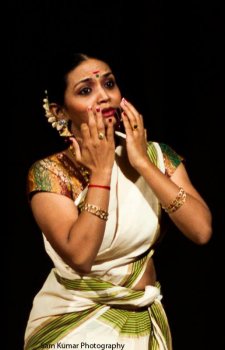 Rashmy Menon (Pic: Sam Kumar) 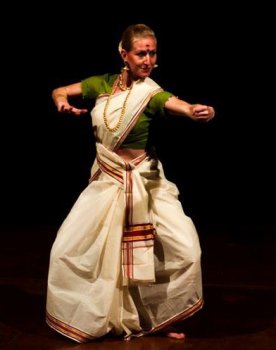 Anne Dietrich (Pic: Sam Kumar) Nanditha Prabhu was awarded the ‘Inspiring and Empowering Dancer’ at Samavesh II by Priya Lasya and Kuchipudi Academy, Chennai. The closing day of Samavesh II had enthralling performances by Anne Dietrich, Rashmy Menon and Nanditha Prabhu. The event was supported by Upasana Foundation and Nrityasree Foundation. Supriya Rajan is a disciple of Dr. Neena Prasad in Mohiniattam. Currently based in Malaysia, she is also pursuing Kathak under Guru Sontosh Maharaj in ICC, KL. She is an administrator of the online Mohiniattam forum, Lasyatarangini. |